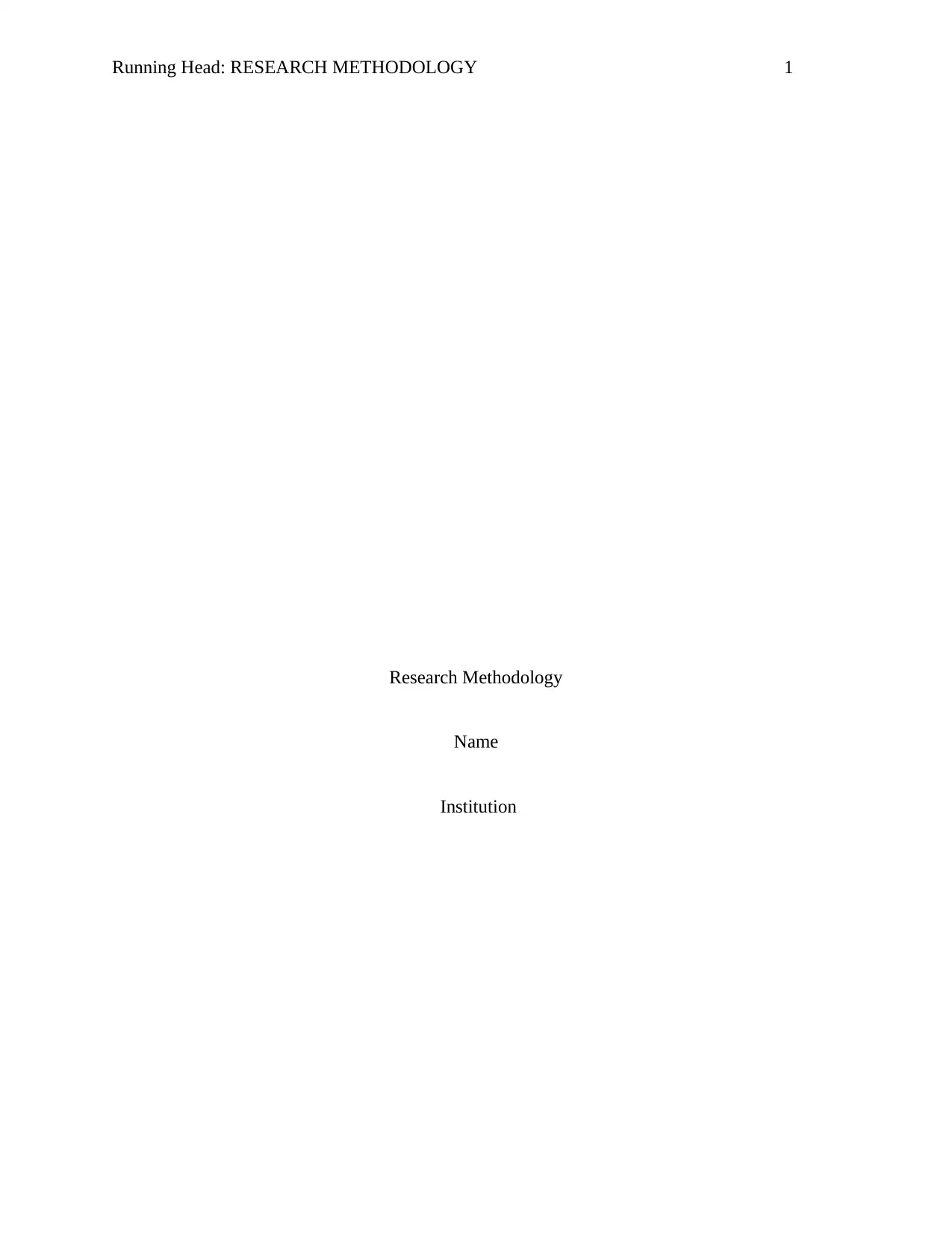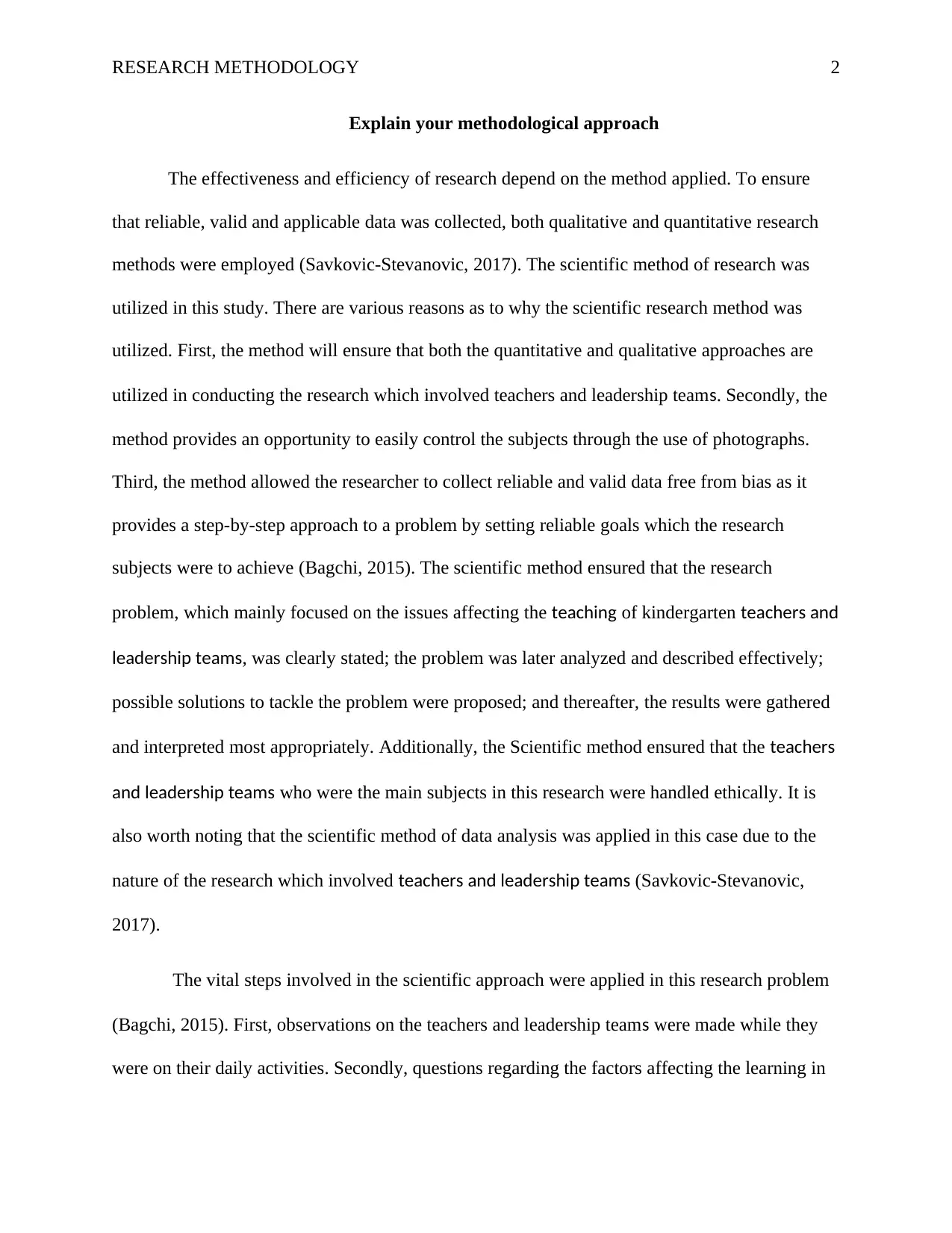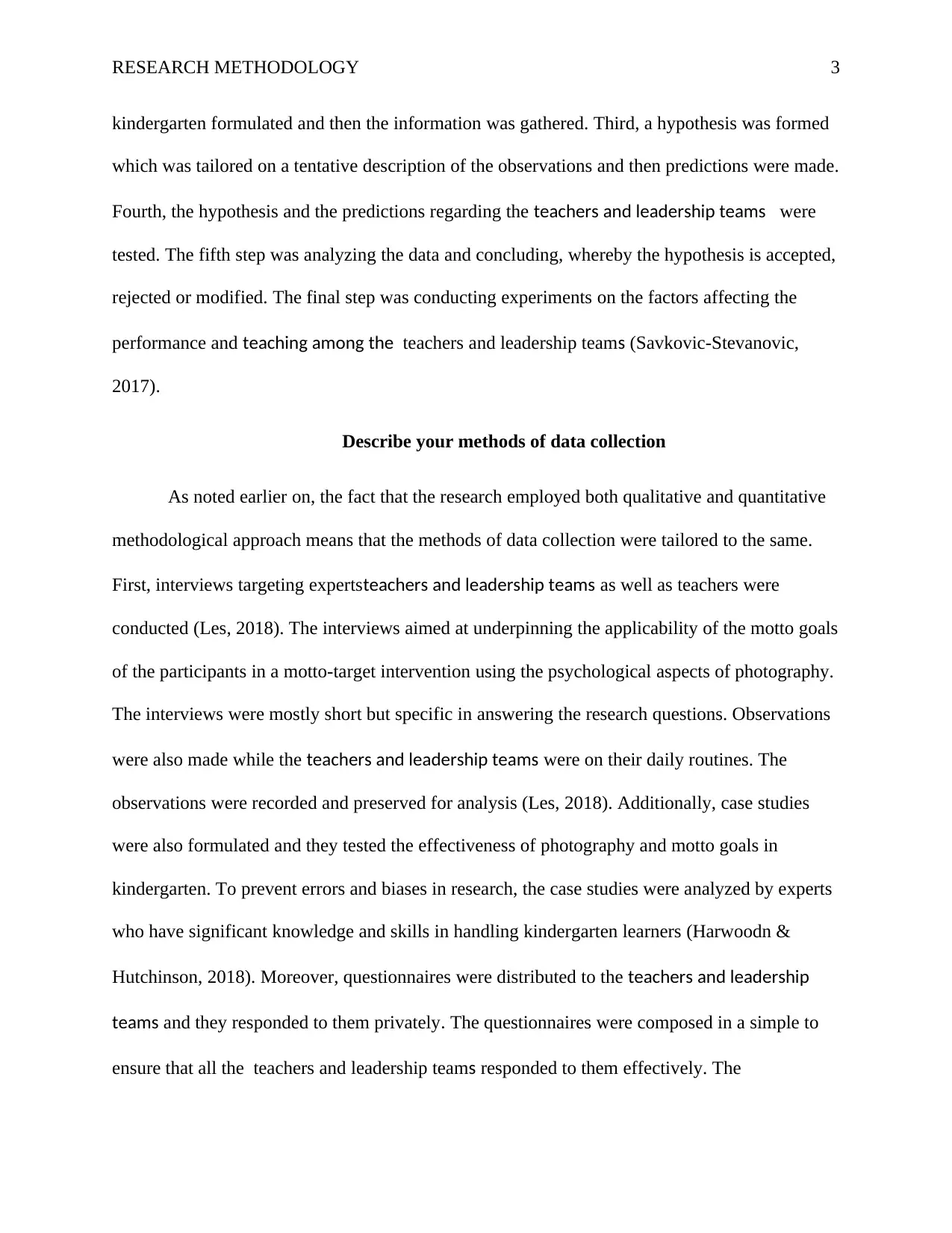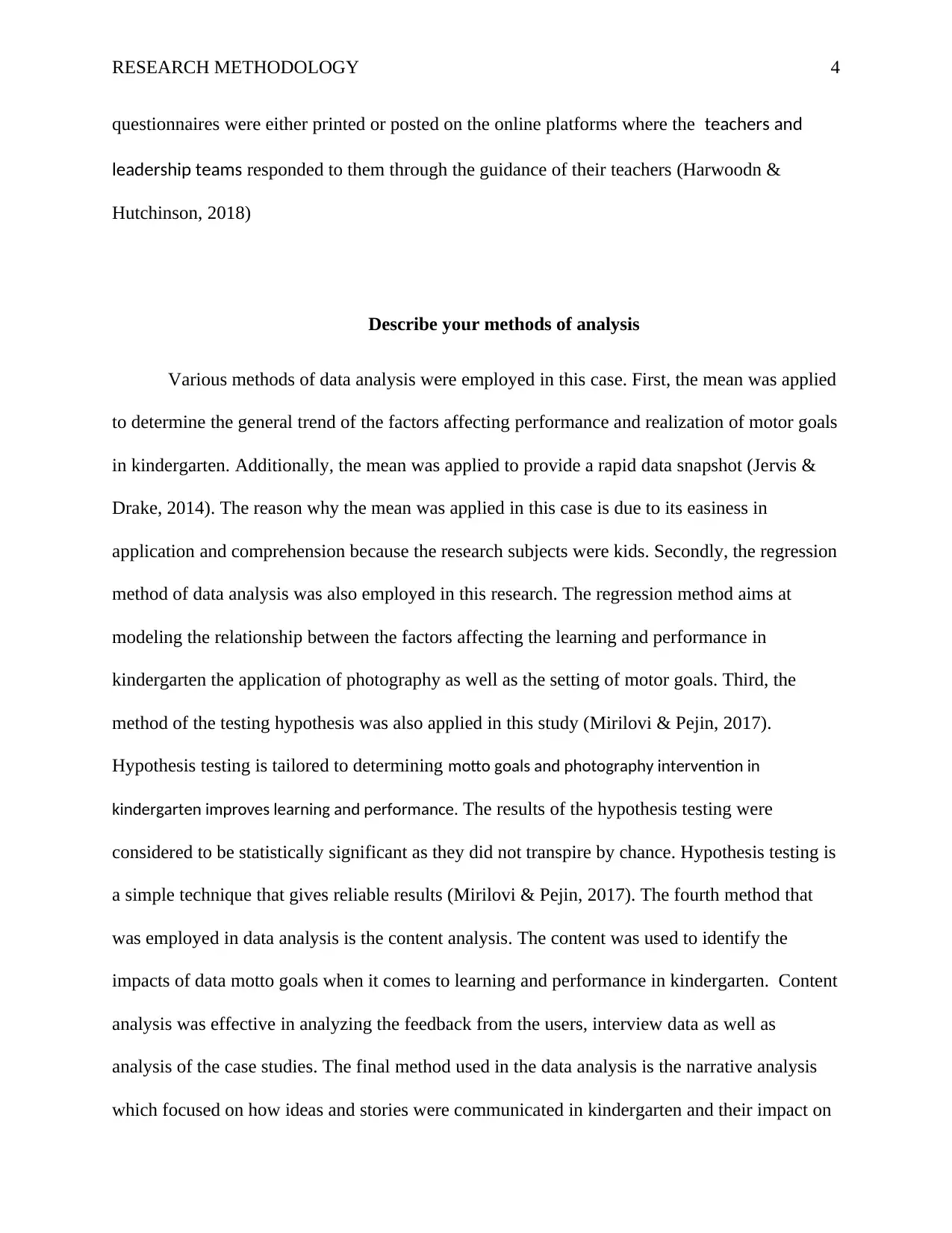Research Methodology Report: Kindergarten Teacher and Leadership
VerifiedAdded on 2022/10/04
|6
|1202
|21
Report
AI Summary
This report presents a comprehensive overview of the research methodology employed in a study focusing on kindergarten teachers and leadership teams. The study utilized a scientific research method, integrating both qualitative and quantitative approaches to ensure reliable and valid data collection. The report details the application of the scientific method, emphasizing its step-by-step approach to address research questions, ensure ethical handling of subjects, and facilitate appropriate data analysis. Data collection methods included interviews, observations, case studies, and questionnaires, tailored to gather diverse perspectives and information. The analysis of the data involved various techniques, including the mean, regression method, hypothesis testing, content analysis, and narrative analysis, each chosen to address specific aspects of the research questions and provide meaningful insights into the factors affecting kindergarten teaching and learning. The report also includes a detailed reference list of the sources used to conduct the research.

Running Head: RESEARCH METHODOLOGY 1
Research Methodology
Name
Institution
Research Methodology
Name
Institution
Paraphrase This Document
Need a fresh take? Get an instant paraphrase of this document with our AI Paraphraser

RESEARCH METHODOLOGY 2
Explain your methodological approach
The effectiveness and efficiency of research depend on the method applied. To ensure
that reliable, valid and applicable data was collected, both qualitative and quantitative research
methods were employed (Savkovic-Stevanovic, 2017). The scientific method of research was
utilized in this study. There are various reasons as to why the scientific research method was
utilized. First, the method will ensure that both the quantitative and qualitative approaches are
utilized in conducting the research which involved teachers and leadership teams. Secondly, the
method provides an opportunity to easily control the subjects through the use of photographs.
Third, the method allowed the researcher to collect reliable and valid data free from bias as it
provides a step-by-step approach to a problem by setting reliable goals which the research
subjects were to achieve (Bagchi, 2015). The scientific method ensured that the research
problem, which mainly focused on the issues affecting the teaching of kindergarten teachers and
leadership teams, was clearly stated; the problem was later analyzed and described effectively;
possible solutions to tackle the problem were proposed; and thereafter, the results were gathered
and interpreted most appropriately. Additionally, the Scientific method ensured that the teachers
and leadership teams who were the main subjects in this research were handled ethically. It is
also worth noting that the scientific method of data analysis was applied in this case due to the
nature of the research which involved teachers and leadership teams (Savkovic-Stevanovic,
2017).
The vital steps involved in the scientific approach were applied in this research problem
(Bagchi, 2015). First, observations on the teachers and leadership teams were made while they
were on their daily activities. Secondly, questions regarding the factors affecting the learning in
Explain your methodological approach
The effectiveness and efficiency of research depend on the method applied. To ensure
that reliable, valid and applicable data was collected, both qualitative and quantitative research
methods were employed (Savkovic-Stevanovic, 2017). The scientific method of research was
utilized in this study. There are various reasons as to why the scientific research method was
utilized. First, the method will ensure that both the quantitative and qualitative approaches are
utilized in conducting the research which involved teachers and leadership teams. Secondly, the
method provides an opportunity to easily control the subjects through the use of photographs.
Third, the method allowed the researcher to collect reliable and valid data free from bias as it
provides a step-by-step approach to a problem by setting reliable goals which the research
subjects were to achieve (Bagchi, 2015). The scientific method ensured that the research
problem, which mainly focused on the issues affecting the teaching of kindergarten teachers and
leadership teams, was clearly stated; the problem was later analyzed and described effectively;
possible solutions to tackle the problem were proposed; and thereafter, the results were gathered
and interpreted most appropriately. Additionally, the Scientific method ensured that the teachers
and leadership teams who were the main subjects in this research were handled ethically. It is
also worth noting that the scientific method of data analysis was applied in this case due to the
nature of the research which involved teachers and leadership teams (Savkovic-Stevanovic,
2017).
The vital steps involved in the scientific approach were applied in this research problem
(Bagchi, 2015). First, observations on the teachers and leadership teams were made while they
were on their daily activities. Secondly, questions regarding the factors affecting the learning in

RESEARCH METHODOLOGY 3
kindergarten formulated and then the information was gathered. Third, a hypothesis was formed
which was tailored on a tentative description of the observations and then predictions were made.
Fourth, the hypothesis and the predictions regarding the teachers and leadership teams were
tested. The fifth step was analyzing the data and concluding, whereby the hypothesis is accepted,
rejected or modified. The final step was conducting experiments on the factors affecting the
performance and teaching among the teachers and leadership teams (Savkovic-Stevanovic,
2017).
Describe your methods of data collection
As noted earlier on, the fact that the research employed both qualitative and quantitative
methodological approach means that the methods of data collection were tailored to the same.
First, interviews targeting expertsteachers and leadership teams as well as teachers were
conducted (Les, 2018). The interviews aimed at underpinning the applicability of the motto goals
of the participants in a motto-target intervention using the psychological aspects of photography.
The interviews were mostly short but specific in answering the research questions. Observations
were also made while the teachers and leadership teams were on their daily routines. The
observations were recorded and preserved for analysis (Les, 2018). Additionally, case studies
were also formulated and they tested the effectiveness of photography and motto goals in
kindergarten. To prevent errors and biases in research, the case studies were analyzed by experts
who have significant knowledge and skills in handling kindergarten learners (Harwoodn &
Hutchinson, 2018). Moreover, questionnaires were distributed to the teachers and leadership
teams and they responded to them privately. The questionnaires were composed in a simple to
ensure that all the teachers and leadership teams responded to them effectively. The
kindergarten formulated and then the information was gathered. Third, a hypothesis was formed
which was tailored on a tentative description of the observations and then predictions were made.
Fourth, the hypothesis and the predictions regarding the teachers and leadership teams were
tested. The fifth step was analyzing the data and concluding, whereby the hypothesis is accepted,
rejected or modified. The final step was conducting experiments on the factors affecting the
performance and teaching among the teachers and leadership teams (Savkovic-Stevanovic,
2017).
Describe your methods of data collection
As noted earlier on, the fact that the research employed both qualitative and quantitative
methodological approach means that the methods of data collection were tailored to the same.
First, interviews targeting expertsteachers and leadership teams as well as teachers were
conducted (Les, 2018). The interviews aimed at underpinning the applicability of the motto goals
of the participants in a motto-target intervention using the psychological aspects of photography.
The interviews were mostly short but specific in answering the research questions. Observations
were also made while the teachers and leadership teams were on their daily routines. The
observations were recorded and preserved for analysis (Les, 2018). Additionally, case studies
were also formulated and they tested the effectiveness of photography and motto goals in
kindergarten. To prevent errors and biases in research, the case studies were analyzed by experts
who have significant knowledge and skills in handling kindergarten learners (Harwoodn &
Hutchinson, 2018). Moreover, questionnaires were distributed to the teachers and leadership
teams and they responded to them privately. The questionnaires were composed in a simple to
ensure that all the teachers and leadership teams responded to them effectively. The
⊘ This is a preview!⊘
Do you want full access?
Subscribe today to unlock all pages.

Trusted by 1+ million students worldwide

RESEARCH METHODOLOGY 4
questionnaires were either printed or posted on the online platforms where the teachers and
leadership teams responded to them through the guidance of their teachers (Harwoodn &
Hutchinson, 2018)
Describe your methods of analysis
Various methods of data analysis were employed in this case. First, the mean was applied
to determine the general trend of the factors affecting performance and realization of motor goals
in kindergarten. Additionally, the mean was applied to provide a rapid data snapshot (Jervis &
Drake, 2014). The reason why the mean was applied in this case is due to its easiness in
application and comprehension because the research subjects were kids. Secondly, the regression
method of data analysis was also employed in this research. The regression method aims at
modeling the relationship between the factors affecting the learning and performance in
kindergarten the application of photography as well as the setting of motor goals. Third, the
method of the testing hypothesis was also applied in this study (Mirilovi & Pejin, 2017).
Hypothesis testing is tailored to determining motto goals and photography intervention in
kindergarten improves learning and performance. The results of the hypothesis testing were
considered to be statistically significant as they did not transpire by chance. Hypothesis testing is
a simple technique that gives reliable results (Mirilovi & Pejin, 2017). The fourth method that
was employed in data analysis is the content analysis. The content was used to identify the
impacts of data motto goals when it comes to learning and performance in kindergarten. Content
analysis was effective in analyzing the feedback from the users, interview data as well as
analysis of the case studies. The final method used in the data analysis is the narrative analysis
which focused on how ideas and stories were communicated in kindergarten and their impact on
questionnaires were either printed or posted on the online platforms where the teachers and
leadership teams responded to them through the guidance of their teachers (Harwoodn &
Hutchinson, 2018)
Describe your methods of analysis
Various methods of data analysis were employed in this case. First, the mean was applied
to determine the general trend of the factors affecting performance and realization of motor goals
in kindergarten. Additionally, the mean was applied to provide a rapid data snapshot (Jervis &
Drake, 2014). The reason why the mean was applied in this case is due to its easiness in
application and comprehension because the research subjects were kids. Secondly, the regression
method of data analysis was also employed in this research. The regression method aims at
modeling the relationship between the factors affecting the learning and performance in
kindergarten the application of photography as well as the setting of motor goals. Third, the
method of the testing hypothesis was also applied in this study (Mirilovi & Pejin, 2017).
Hypothesis testing is tailored to determining motto goals and photography intervention in
kindergarten improves learning and performance. The results of the hypothesis testing were
considered to be statistically significant as they did not transpire by chance. Hypothesis testing is
a simple technique that gives reliable results (Mirilovi & Pejin, 2017). The fourth method that
was employed in data analysis is the content analysis. The content was used to identify the
impacts of data motto goals when it comes to learning and performance in kindergarten. Content
analysis was effective in analyzing the feedback from the users, interview data as well as
analysis of the case studies. The final method used in the data analysis is the narrative analysis
which focused on how ideas and stories were communicated in kindergarten and their impact on
Paraphrase This Document
Need a fresh take? Get an instant paraphrase of this document with our AI Paraphraser

RESEARCH METHODOLOGY 5
learning and performance. The narrative analysis was mostly applied in analyzing opinions and
ideas from kindergarten learners (Mirilovi & Pejin, 2017).
References
Bagchi, A. (2015). The Place of Quantitative Methods in a Management Curriculum. Decision
(0304-0941), 32(2).
Harwoodn, E., & Hutchinson, E. (2018). Data Collection Methods Series Part 5. Journal Of
Wound, Ostomy And Continence Nursing, 36(5), 476-481. DOI:
10.1097/won.0b013e3181b35248
Jervis, M., & Drake, M. (2014). The Use of Qualitative Research Methods in Quantitative
Science: A Review. Journal Of Sensory Studies, 29(4), 234-247. DOI:
10.1111/joss.12101
Lee, S. J. (2018). Quantitative versus qualitative research methods—Two approaches to
organization studies. Asia Pacific Journal of Management, 9(1), 87-94.
Mirilovic, M., & Pejin, I. (2017). Application of descriptive statistics in the analysis of
experimental data. Veterinarski Glasnik, 62(1-2), 85-95. DOI: 10.2298/vetgl0802085m
Savkovic-Stevanovic, J. (2017). Modeling Method in the Scientific Research. Science Research,
3(3), 66. DOI: 10.11648/j.sr.20150303.14
learning and performance. The narrative analysis was mostly applied in analyzing opinions and
ideas from kindergarten learners (Mirilovi & Pejin, 2017).
References
Bagchi, A. (2015). The Place of Quantitative Methods in a Management Curriculum. Decision
(0304-0941), 32(2).
Harwoodn, E., & Hutchinson, E. (2018). Data Collection Methods Series Part 5. Journal Of
Wound, Ostomy And Continence Nursing, 36(5), 476-481. DOI:
10.1097/won.0b013e3181b35248
Jervis, M., & Drake, M. (2014). The Use of Qualitative Research Methods in Quantitative
Science: A Review. Journal Of Sensory Studies, 29(4), 234-247. DOI:
10.1111/joss.12101
Lee, S. J. (2018). Quantitative versus qualitative research methods—Two approaches to
organization studies. Asia Pacific Journal of Management, 9(1), 87-94.
Mirilovic, M., & Pejin, I. (2017). Application of descriptive statistics in the analysis of
experimental data. Veterinarski Glasnik, 62(1-2), 85-95. DOI: 10.2298/vetgl0802085m
Savkovic-Stevanovic, J. (2017). Modeling Method in the Scientific Research. Science Research,
3(3), 66. DOI: 10.11648/j.sr.20150303.14

RESEARCH METHODOLOGY 6
⊘ This is a preview!⊘
Do you want full access?
Subscribe today to unlock all pages.

Trusted by 1+ million students worldwide
1 out of 6
Related Documents
Your All-in-One AI-Powered Toolkit for Academic Success.
+13062052269
info@desklib.com
Available 24*7 on WhatsApp / Email
![[object Object]](/_next/static/media/star-bottom.7253800d.svg)
Unlock your academic potential
Copyright © 2020–2025 A2Z Services. All Rights Reserved. Developed and managed by ZUCOL.





